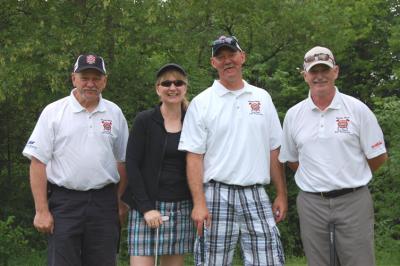
Editor’s blog
Laura King
Features Blogs Editor’s blogJune 28, 2011
I wasn’t going to get bent out of shape about the editorial in the
Brantford Expositor last week by reporter Chris Brennan, who seems to
have a bone to pick with first responders.
June 28, 2011
I wasn’t going to get bent out of shape about the editorial in the Brantford Expositor last week by reporter Chris Brennan, who seems to have a bone to pick with first responders.
Mr. Brennan – clearly a cynic like most reporters I know (and I was one of them, so I know!) notes that two miners were killed in Sudbury on June 8 and that the tragedy warranted only a brief mention in some Canadian newspapers, nothing at all in others, including the Expositor. “Now just imagine if it had been two police officers or firefighters who had been killed,” Mr. Brennan says. “It would have been front-page news across the country.”
Darn right, as it is today, with the death of York Region Const. Garrett Styles, who was dragged 300 metres by a van driven by a 15-year-old before the vehicle flipped on top of the officer. Styles later died from his injuries.
Today’s news stories note that Styles, 32, and a married father of two young children, was worried that the teenagers in the van were injured, even while he was being crushed to death – typical of his nature, according to the reports.
The Toronto Star editorial today , titled Const. Styles selfless call, says “police, firefighters and paramedics place themselves in harm’s way every day, just going about their jobs. Toronto mourned Sgt. Ryan Russell earlier this year, when he was killed trying to stop a rampaging snowplow.” It doesn’t mention the two volunteer firefighters killed on duty in Listowel in March, but the focus of this particular editorial is on police officers.
Regardless, today’s full-on coverage of Styles’ death – at least in the Toronto media – and coverage of the ceremony that will follow, will indeed be front-page news.
But Mr. Brennan doesn’t think that’s fair. “Another thing: The massive funeral processions for fallen comrades is getting a little stale and self-indulgent,” he says in the editorial. “Enough, already. If every profession or occupation marked the death of one of its members the way cops and firefighters do the streets would be jammed with marching mourners 24 hours a day and the economy would grind to a halt.”
Enter Trent Elyea, the fire chief in Collingwood, Ont., who responded to the Expositor editorial in a letter to the editor, as did several others.
Given the events of yesterday, and figuring that Chief Elyea’s work and
life experiences give him far more authority than most, here’s an
edited version of his reply:
What is disturbing within the [editorial]is the part about how we pay tribute to our fallen . . . It is tradition, it reminds us of why we do what we do. It gives us a sense of loss that we carry with us each and every day because we understand what the sacrifice was. If other occupations choose not to pay that kind of respect to their brothers and sisters, so be it. That is a choice that they make. With us, that is how we deal with our dead; it is our way.
The reality is that while you lay in your bed, go to work, walk down the street and life throws a curve at you, it is expected that one of our professions will come and save you. Regardless if it is a smashed up car, a house fire or a home invasion . . . the expectation is that we will come. And we do. That is our job and that is what we do every day. I can see where you can view other professions as dangerous and I can also understand why one would ask why we pay tribute the way we do. Granted there are many professions out there that have dangerous parts to their job and we respect and work with most of those individuals daily . . . Every time you watch the news where tragedy has struck anywhere, who do you see? Us, helping people and cleaning up the mess that has been bestowed upon some poor individual or a greater part of the population.
If the writer could see the anguish and pain and suffering that the emergency services see all too frequently, then maybe he would appreciate the fact that these individuals spend most, if not all their adult lives, dedicated to helping others. They ask nothing for it. Each day, all three agencies go to work and they face the worst of what life can throw at someone and never know when or if they will return. Yet each day they go to work with the pride and honor that has been bestowed upon them, knowing that the next call they run can make a difference in someone’s life . . . All we ever ask for is the use of the streets to parade, so thousands of us can pay respect, and a small piece of land to bury them in; nothing more, nothing less.
Interestingly, a letter to the editor from the president of the Sudbury
Professional Firefighters Association was published in the Expositor last week – and you can read it here. It’s safe to say that Mr. Brennan did little or no research before launching his rant. Shame.
–
There was plenty of chatter and concern at the Wasaga Beach Fire Chief’s Golf Tournament Friday about former Oakville Fire Chief Richard Boyes. Boyes has been a key player in policy and strategy matters for the Ontario Association of Fire Chiefs, and a point person on issues from mandatory sprinklers to presumptive legislation for volunteer firefighters. The consensus is that Boyes will land on his feet.
A story in Oakville’s community paper
over the weekend shed little light on Boyes situation. As mentioned last week, e-mails that started arriving last Wednesday morning said simply that Boyes is no longer the chief in Oakville. Here’s the link to the story, which says Boyes resigned, along with another Oakville official – not exactly the same story we’re hearing.
Deputy Chief Lee Grant – the former chief in Peterborough, Ont. – is acting fire chief in Oakville. There’s no word so far on potential candidates for the chief’s job . . .
–
It stopped raining in time for the first annual Wasaga Beach Fire Chief’s Golf Tournament last Friday but that didn’t necessarily help the play of our foursome – Wasaga Beach Fire Chief Mike McWilliam, Wasaga Beach Deputy Chief Wes Higgins, retired Mississauga firefighter Don MacDonald, and me.

|
|
| We look good, if nothing else! Deputy Chief Wes Higgins, FFIC editor Laura King, Chief Mike McWilliam and Don MacDonald. Photo by Stef Wallace. |
Actually, everyone played well by times – although not nearly as well as the winning A.J. Stone team, which came in at 11 under, one better than the Richmond Hill/Markham/Whitchurch-Stouffville team.
Note to participants: Horizontally striped shirts and vertically striped pants are distractions, not fashion statements! (See more photos on our Facebook page!)
 |
 |
| What an outfit . . . 'Nuff said. Photo by Stef Wallace. |
We heard there's a story behind this shirt – something about a bet. But we think Chief Kevin Foster won because it's not that bad!! Photo by Stef Wallace. |
The tournament (great swag bags, by the way!) raised $5,000 for local charities and Chief McWilliam promises to run the event next year.

|
|
| Shhh. Don't tell the fire chief . . . Photo by Stef Wallace. |
–
There’s a bit of a reprieve in the travel schedule for a couple of weeks before we head to Fredericton for the Maritime Fire Chiefs Association conference July 17-20. Fire Fighting in Canada/Canadian Firefighter and EMS Quarterly sales manager Catherine Connolly, Firehall Bookstore manager Becky Atkinson, and I will be in New Brunswick’s lovely (and usually very warm!) capital for the 97th annual MFCA trade show and the educational seminars.
Meantime, we’re wrapping up our July issue of Canadian Firefighter and EMS Quarterly, which features a gripping narrative by Chief Jamie Coutts on the Slave Lake wildfires. It will be posted online shortly.
–
Finally, stories about the wildfires in New Mexico have been filtering into my BlackBerry for days but here’s a blog/story from a U.K.-based tech writer that provides a different view – literally – through Google Earth. If you have a few minutes, read the blog entry, click on the link to the U.S. Forest Service then on Fire Data, which takes you to the Active Fire Mapping Program page, and a new perspective on wildfires.
Print this page